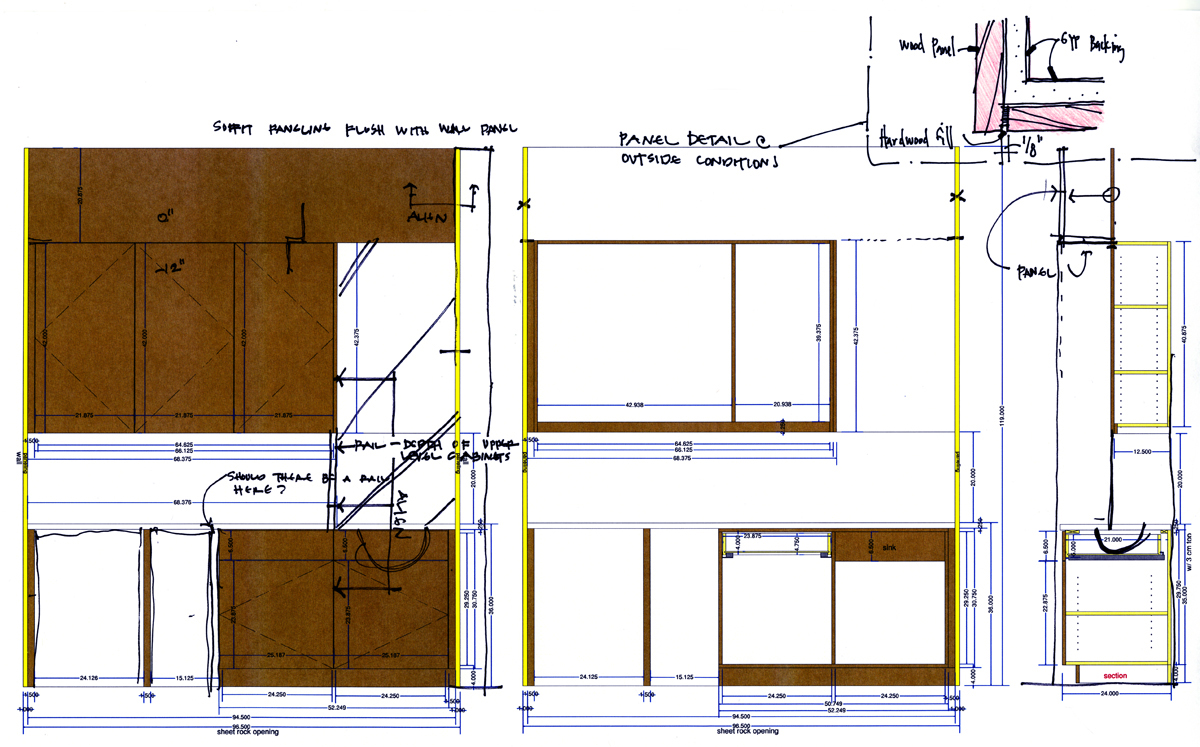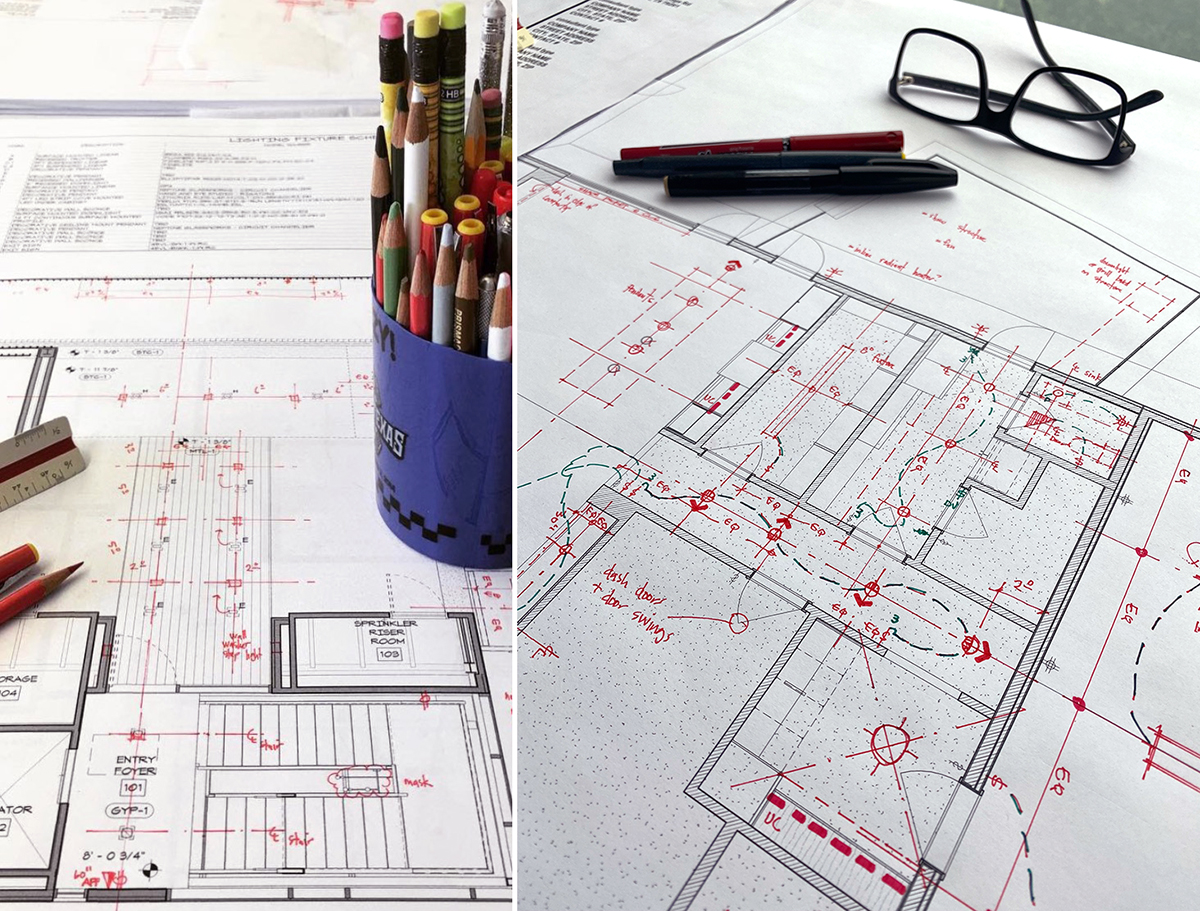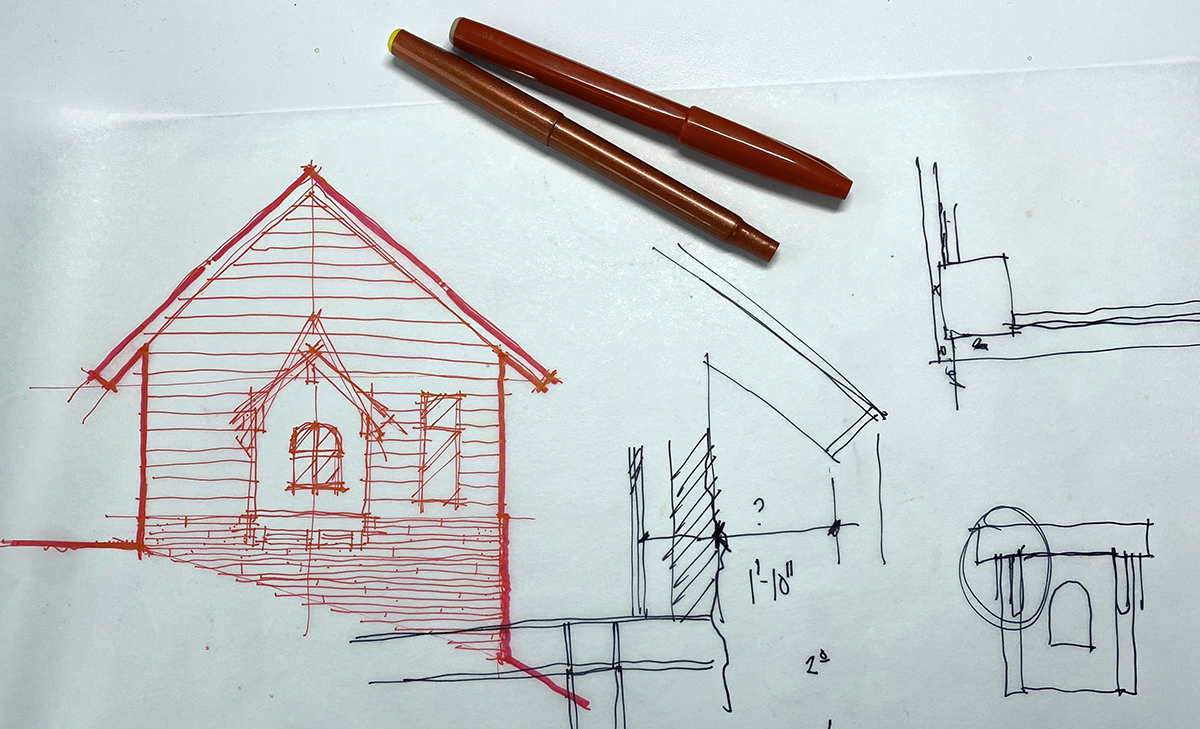“Redlines” is the word used in an architectural office to reference the red ink that is typically used to mark up corrections that need to be made on architectural drawings. Is this phrase outdated? Do people even use red anymore? Does the experience send some into some form of post-traumatic stress disorder? This is what we will be discussing today in Episode 78 “Redlines”.
[Note: If you are reading this via email, click here to access the on-site audio player]
Podcast: Embed
Subscribe: Apple Podcasts | Spotify | Android | iHeartRadio | TuneIn
Redlines During the Design Process jump to 5:57
I have become accustomed to people who only know 1/10,000th of the story I am sharing feeling the need to tell me all the things I’ve screwed up whenever I post pictures to social media, but even I was a little shocked at the response I received when I published an image that I had posted that showed a redline comment I had made. Of course, once I posted the image there were the typical sorts of comments that I expected to see, but what surprised me was how the note “wow … terrible” was perceived based on the lack of context in which it was presented.
Not one single person interpreted my comment correctly … zero. It was assumed that this particular comment was directed at the person who drew this elevation, that they had done a terrible job … that my comment was an indictment of the individual and not the actual design. Many of the comments were chastising me for providing worthless and demoralizing feedback that would accomplish nothing other than making the person who drew this elevation feel bad.
… and those people could not have been more wrong. Wronger.
If you are interested in the rest of the story, as well as the follow-up sketches that came after the note shown above, you can find them in the post “Architectural Redlines During Design“.
Redlines as a Tool for Teaching jump to 12:52

The best way to have the redlines process happen is to make it a teaching exercise. They should be utilized to make the person who is picking up the redlines understand the reasons for those corrections. This is an ideal way to make the process less of a one-sided delivery process and more of a transfer of knowledge. While this process will take longer in the beginning, the lessons learned should pay off in the knowledge that down the line diminishes those needs. If I can explain the reasons for the redlines and transfer that knowledge, then hopefully it will not need to be conveyed again. This transference of information is important to both the future architect and to the overall architectural profession. It is important to use the redline process as a way to pass along the expertise of the more senior professional to the less experienced.
The Value of Redlines – Creating AND Picking Them Up jump to 12:52

There is a downside to how maniacal you can get with your redline process. I worked in an office – it was a good office and I still have a lot of respect for the people who run and manage that place – but one of the partners was an absolute working machine and he would come up to the office on weekends, stay late and night all the time, and redline the drawing of the younger staff. He wanted you to highlight the changes and modifications that you made in real-time … pick something up, then highlight it as done. One at a time, Back and Forth. And he wanted everyone to save his original redlined drawings so that he could check to make sure that you actually picked up all the redlines he had put on the page. All I can say is that if you had highlighted a redline but not actually picked it up, you might get murdered. He was not wrong in being irritated at this sort of mistake, but he had a fiery attitude, and people were scared of making him angry. As these behaviors played out, people would pick up every single redline on the page without actually thinking about what they were doing or why? What could have been a fantastic teaching tool turned into one of the worst.
Redlining by Hand vs. Using Software jump to 27:08

I think redlines are really about giving direction because at a certain point, it doesn’t make much sense to draw the redline comments to such a level of detail, might as well enter it directly into the drafting software at that point … but that doesn’t work because in most offices, the person doing the redlining bills out at a different rate than the person picking up the redline. As a result, redlines are supposed to convey information and direction, quickly and efficiently, which brings us full circle back to your point. They don’t always tell you enough to be practical but you can’t spend the time creating to make it financially viable if you do.
I sort of fall into the older generation architects bracket – came out of school in 1992. I drew by hand for the first 3 years but have been digital ever since. I’m not against doing them digitally, I’m just faster with my comments when creating them manually.
HOWEVER …
Software like Bluebeam, which is an incredibly powerful program, allows collaboration and exchange in a way that traditional redlines would struggle with. I could pass around a piece of paper and all the different parties could mark their comments on it, but that is iterative and NOT very engaging.
For those of you who listened to the podcast and might be interested in the article that mentioned the redlines of Lee Calisti, you can find it here. and you can listen to this section jump to 44:41
Would you rather? jump to 46:58

Andrew knew what his answer would be, immediately. I knew what Andrew’s answer would be … also immediately. But my decision was quite a bit more difficult to decide.
Would you rather have a dog, or a cat?
Cats are easier to care for and overall less of a responsibility, but dogs provide an unconditional love that is a boost for many. There is a lengthy discussion about the pros and cons of each type of pet, but in the end, the decisions were not the same … well maybe. One of us is still not truly clear on that final choice.
Ep 078: Redlines
While redlines appear to have a negative connotation within the industry, they really should be used as a tool for teaching the next generation of architects. When utilized properly they can be a benefit to all involved in the process. This may require a concentrated effort on the part of the elder, more experienced professional, and it should be an integral part of a collaborative process. It is not just a time to blindly follow directions and make verbatim corrections, it is a time to learn about all the elements for creating architecture and comprehending the requirements of creating clear and concise representations of our ideas into the built environment. So the next time the redlines come around, both sides of the table can put in the effort to glean the best from the process.
Cheers,

Life of an Architect would like to thank today’s sponsor – Petersen, maker of PAC-CLAD architectural metal cladding. To inquire about perforated metal or Petersen’s metal roof and wall cladding products send an email to info@pac-clad.com, or call (800) PAC-CLAD (722-2523).
We would also like to thank our media partners Building Design and Construction for their gracious and ongoing support of this podcast. This is the 3rd year of our partnership and we are grateful for the guidance and insight they share with us that helps direct the show.

